Gold slides lower amid profit-taking ahead of key US data
Global gold prices dropped by more than 1% during these trading moments on Thursday, as investors engaged in profit-taking ahead of crucial US economic data that could provide further signals on when and by how much the central bank might cut interest rates this year.
Markets are awaiting the release of US Gross Domestic Product (GDP) data scheduled for 15:30 Riyadh time, and Personal Consumption Expenditures (PCE) data – the Federal Reserve’s preferred inflation gauge – on Friday to glean more insights into the timing of potential US interest rate cuts. Traders anticipate the Federal Reserve to finally cut interest rates long-awaited in September. Non-yielding bullion tends to shine in a low-interest rate environment. If PCE data shows inflation slowing and the Federal Reserve can cut rates in September, we might see a recovery in gold prices.
Gold and Dollar Now:
- Gold futures are currently down 1.7% to $2,374 per ounce.
- Meanwhile, spot gold contracts dropped about 0.9% to $2,375 per ounce.
- On the other hand, the US Dollar Index is down 0.08% to 104.03 points.
- Other Metals:
Silver in spot trading fell by 4.2% to $27.78 per ounce during the day.
Platinum decreased by 1.3% to $935.90, and palladium fell by 1.6% to $917.75.
Wall Street Sees Collective Decline: Tesla Stock Collapse and Gold Drop:
The S&P 500 index sharply declined on Wednesday, influenced by technology stocks following disappointing second-quarter results from tech giants like Alphabet and Tesla. By the end of the US session, the Nasdaq fell by 3.47%, S&P 500 by 2.2%, and Dow Jones by 1.23%.
Gold also fell by 0.33% for spot contracts, trading at $2,401.8 per ounce, while the US Dollar Index steadied at 104.110 against a basket of foreign currencies. Trading saw severe declines for major tech companies, notably Tesla, which dropped more than 12% in today’s trading session following disappointing earnings data.
Tesla (NASDAQ) declines due to profit dip and worsening outlook. Tesla (NASDAQ) shares dropped by about 10% after second-quarter earnings fell below expectations amid declining car sales. Tesla’s profit margins hit a five-year low as the company significantly reduced prices to confront increased competition in major markets like China. Despite margin pressures, some on Wall Street remain optimistic about the stock due to expectations around future growth opportunities, including robotaxis.
Wedbush commented: “While margin weakness is impacting the stock…the next phase of Tesla’s growth story revolves around robotaxis and AI, and this vision is on the horizon.” Alphabet Stock Falls Despite Beating Earnings Expectations; Seagate Surges
Alphabet’s (NASDAQ) shares dropped by 5% despite exceeding second-quarter earnings expectations thanks to increased ad sales and strong demand for cloud services. Alphabet’s strong performance in search and cloud was offset by “weak performance in YouTube, largely due to tough comps, and continued weakness in Google Network,” according to Deutsche Bank (ETR).
Seagate Technology PLC (NASDAQ), however, defied tech sector slowdowns with a 5% rise on strong fourth-quarter results surpassing Wall Street estimates, driven by increased demand for AI-driven data storage.
Former Fed Chair Dudley Changes Stance, Calls for Rate Cut Next Week
Former Federal Reserve Chair Bill Dudley called for interest rate cuts as soon as next week amid recession fears, reversing his long-term view that the Fed should maintain higher interest rate regimes for longer. Dudley stated ahead of the Federal Reserve’s July 30-31 meeting: “The facts have changed, so I’ve changed my mind. The Fed should cut rates, and preferably that should happen at next week’s policy meeting.”
Visa Revenue Falls Short of Expectations, AT&T Surprises with Positive Earnings
Outside of the tech sector, Visa (NYSE) reported third-quarter results that exceeded Wall Street’s expectations, but weak payment volume growth pointed to consumer weakness, impacting sentiment and causing a 3% decline in its share price. RBC noted on Wednesday: “It appears that the marginal consumer is weakening, with trends in the US slowing to July 21 with payment volume growth at 4% versus 5%.”
Texas Instruments (NASDAQ) stock held steady after the chipmaker reported strong second-quarter earnings, surpassing adjusted earnings per share estimates. AT&T (NYSE) shares rose by 4% after the telecom giant exceeded market expectations for wireless subscriber additions in the second quarter, driven by its high-tier unlimited plans.
Oil Prices Decline Amid Concerns Over Chinese Demand and Middle East Peace Talks
Oil prices fell on Thursday, influenced by concerns over weak Chinese demand and potential ceasefire talks in the Middle East. Brent crude futures for September delivery dropped by 38 cents to $81.33 per barrel, while US West Texas Intermediate for the same month decreased by 33 cents to $77.26 per barrel.
This decline in oil prices occurred despite gains on Wednesday, breaking a streak of losses over three sessions, following a report from the Energy Information Administration. The report indicated a significant drawdown in US crude oil inventories, which decreased by 3.7 million barrels last week, surpassing analysts’ expectations of a 1.6 million barrel drawdown.
Additionally, US gasoline inventories saw a substantial decline of 5.6 million barrels, much higher than the expected drawdown of 400,000 barrels. Distillate inventories also fell by 2.8 million barrels, challenging expectations of a 250,000 barrel increase. Despite these inventory draws, market focus remained on weak Chinese demand and progress in ceasefire talks between Israel and Hamas, adding pressure on oil prices. China’s imports of oil and refinery operations in 2024 are expected to decline compared to 2023, reflecting economic growth slowdown and decreased fuel demand.
US stock market performance also played a role, with all three major Wall Street indexes closing lower on Wednesday, indicating reduced risk appetite among traders.
Geopolitically, discussions on a ceasefire to end the conflict in Gaza between Israel and Hamas made progress under a plan initiated by US President Joe Biden in May with support from Egypt and Qatar. Israeli Prime Minister Benjamin Netanyahu recently discussed a vision of “eradicating extremism” in Gaza post-conflict, hinting at a potential alliance between Israel and Arab allies to the United States. If ceasefire talks continue to progress, coupled with ongoing declines in US stocks and persistent economic weakness in China, oil prices may return to levels seen in early June.
Disclaimer: This article is not investment advice or an investment recommendation and should not be considered as such. The information above is not an invitation to trade and it does not guarantee or predict future performance. The investor is solely responsible for the risk of their decisions. The analysis and commentary presented do not include any consideration of your personal investment objectives, financial circumstances, or needs.





